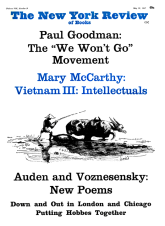In response to:
News from Nowhere from the March 9, 1967 issue
To the Editors:
“The pedantic art historian,” writes Francis Haskell, [NYR, March 9] recently appointed Professor of the History of Art at Oxford University, “is certainly wise to be cautious when faced with an anthology of this nature,” i.e. The Grand Eccentrics. He “may well feel after browsing through its glossy pages, for God’s sake let us have some conformity.”
The delights of conforming are universal; artists who resist them often are paid off with neglect in their lifetimes and a few footnotes from such tidy art historians as Professor Haskell. Of course, he recognizes that there are “exceptions,” but he obviously feels that all we need to make them look in step with the times is more research from the History of Art Department. Botticelli and El Greco are his cases in point. They seemed eccentric at one stage of the game, but as more evidence was brought in, they were set firmly within tradition. Thus according to the Professor, all we need is enough cautious pedantic art historians and all nagging questions will be answered, all mysteries cleared away, all art will be programmed into a system-machine that can resolve all ambiguities. Blake will lie down beside Raeburn, Ryder will sup with Sargent, and the beautiful Grandville drawings which make your Review such a pleasure to look at, will be brothers to Gustave Doré’s illustrations.
The only cloud in this sweet dream of a reasonable universal art history is that there is a certain amount of chaos in art, and one of its manifestations is the appearance of eccentrics. They keep popping up to challenge the best categories and baffle the most patient archivists. As artists, they come out of art, of course. All art comes out of art. But they are apt to develop as strangely as Sade evolved from Candide.
And in a period when younger artists tend to huddle in categories, the eccentrics are welcome examples of how to stand on one’s own (in America; at least, and America is where major modern art is being made today; perhaps in England artists should be urged to think about joining movements).
We are also in a period when art historians are attempting to hi-jack all modern art into their ready-made pigeonholes. So we can welcome one category which, by definition, is only describable—never definable: The Eccentric.
Thomas B. Hess
Editor, Art News
New York City
PS: Professor Haskell asks to be shown an “eccentric” Giotto. Let him browse through the glossy pages of a book on Giotto until he comes to the angels in the Lamentation over the Body of Christ in Padua, or, being an art historian, he may prefer to read about art; he might look up Proust’s description of the allegorical figure of Anger.
Francis Haskell replies:
Mr. Hess has so far missed the point of my review that it hardly seems worthwhile bothering to reply. Far from wishing to be excessively “tidy” I went out of my way to agree with his statement that “each man’s oeuvre, indeed each single painting, lives primarily as it goes beyond the boundaries of a textbook tag”; what I find objectionable in his modish and trivial book is what seems to me a willful determination to misunderstand the oeuvres of noble and serious artists by lumping them together with relatively insignificant works and categorizing the whole bundle as “eccentric.” I also tried to point out that the contributors to his volume, for most of whom I have the very highest respect (whether professors or not), do not make this error of taste which is surely as degrading to the artists concerned as it is to a sense of history, tidy or untidy. I am perfectly familiar with Giotto’s frescoes at Padua, and am unable to see why the angels in the Lamentation over the Body of Christ should be described as any more “deliriously eccentric” (Mr. Hess’s adverb, now dropped) than the other figures in that magnificent composition: such a distinction, I’m afraid, only confirms my worst suspicions about his discrimination and judgment.
This Issue
May 18, 1967



